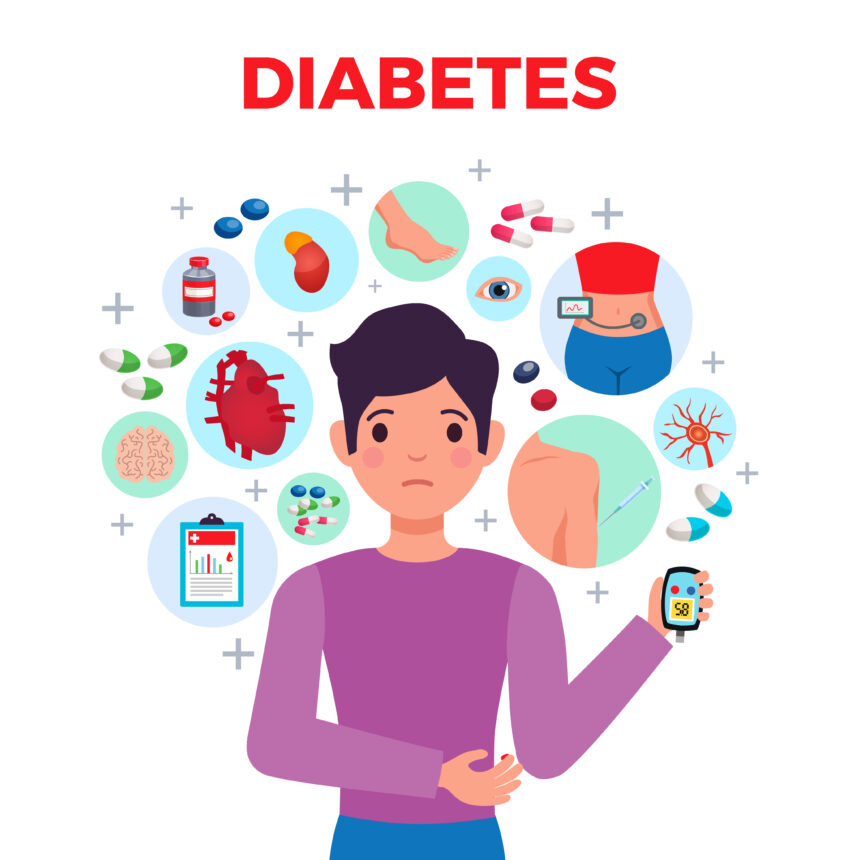image by macrovector on freepik
Diabetes is a widespread, chronic health condition that affects the body’s ability to convert food into energy. It is characterized by an excess of glucose, or sugar, in the bloodstream. This article aims to provide a detailed understanding of diabetes, its types, symptoms, causes, risk factors, and how to effectively manage and prevent it.
What is Diabetes?
Diabetes is a group of metabolic diseases that impact the body’s ability to use blood sugar, also known as glucose. Glucose is a critical source of energy for the cells that make up muscles, tissues, and the brain. When the body’s interaction with insulin, a hormone that controls the distribution of glucose into the cells, is disrupted, diabetes can occur.
In a healthy body, the pancreas releases insulin into the bloodstream as the blood sugar level rises. This insulin acts as a key, allowing the glucose to enter the cells and be used as energy. However, with diabetes, the body either fails to produce sufficient insulin or the cells become resistant to insulin. As a result, glucose remains in the bloodstream, leading to high blood sugar levels that can cause severe health problems over time.
Types of Diabetes
There are several forms of diabetes, and each has unique characteristics and causes. The three primary types of diabetes are Type 1, Type 2, and Gestational Diabetes. Other less common types include Prediabetes, Type 1.5 (also known as Latent Autoimmune Diabetes in Adults or LADA), and Type 3c diabetes.
Type 1 Diabetes
Type 1 diabetes, previously known as juvenile diabetes, is usually diagnosed in children and young adults. In this form, the body’s immune system mistakenly attacks the insulin-producing cells in the pancreas, leading to an insulin deficiency. As a result, individuals with Type 1 diabetes must take insulin daily to survive.
Type 2 Diabetes
Type 2 diabetes is the most prevalent form of diabetes, accounting for approximately 90% to 95% of all diagnosed cases. In type 2 diabetes, the body does not use insulin effectively, leading to insulin resistance. Over time, the pancreas fails to produce enough insulin to regulate blood sugar levels.
Gestational Diabetes
Gestational diabetes occurs in some women during pregnancy. While it typically resolves after childbirth, women who experience gestational diabetes have an increased risk of developing type 2 diabetes later in life.
Prediabetes
Prediabetes, or borderline diabetes, is a condition where blood sugar levels are higher than normal but not high enough for a type 2 diabetes diagnosis. Without intervention, prediabetes can evolve into type 2 diabetes, raising the risk for heart disease and stroke.
Symptoms of Diabetes
The symptoms of diabetes may vary depending on the type and severity of the condition. In many cases, the symptoms may be so mild that they go unnoticed. Common symptoms across all types of diabetes include increased thirst, frequent urination, unexplained weight loss, fatigue, blurred vision, slow-healing sores or cuts, and frequent infections.
Causes of Diabetes
While the exact cause of diabetes is not fully known, it is understood that both genetic and environmental factors play a significant role. In type 1 diabetes, an autoimmune reaction occurs, causing the body to mistakenly attack the insulin- producing cells in the pancreas. In type 2 diabetes, lifestyle factors such as obesity and physical inactivity contribute to the development of insulin resistance.
Risk Factors for Diabetes
Several factors can increase your risk of developing diabetes. These include being overweight or obese, being physically inactive, having a family history of diabetes, having high blood pressure, cholesterol or triglycerides levels, and being over the age of 45. Certain racial and ethnic groups, including African Americans, Hispanic Americans, and Asian Americans, are also at a higher risk of developing type 2 diabetes.
Complications of Diabetes
If left unmanaged, diabetes can lead to a variety of serious health complications. These include heart disease, stroke, nerve damage (neuropathy), kidney disease (nephropathy), eye damage (retinopathy), foot problems, and skin conditions. Diabetes can also increase the risk of mental health issues such as depression and anxiety.
Managing Diabetes
Managing diabetes involves a combination of medical treatment and lifestyle changes. This can include taking prescribed medication, following a healthy diet, engaging in regular physical activity, and monitoring blood sugar levels. Regular check-ups with healthcare providers are also crucial to managing diabetes effectively.
Prevention of Diabetes
While some risk factors for diabetes, such as age and genetic predisposition, cannot be changed, many can be controlled through lifestyle modifications. These include maintaining a healthy weight, eating a balanced diet, engaging in regular physical activity, and avoiding tobacco use. If you have been diagnosed with prediabetes, these lifestyle changes can help reverse the condition and prevent the onset of type 2 diabetes.


